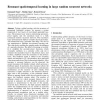94 search results - page 14 / 19 » Control Structures in Hypothesis Spaces: The Influence on Le... |
CIDM
2009
IEEE
13 years 11 months ago
2009
IEEE
The graph classification problem is learning to classify separate, individual graphs in a graph database into two or more categories. A number of algorithms have been introduced fo...
TFS
2008
13 years 7 months ago
2008
Abstract--This study proposes an efficient self-evolving evolutionary learning algorithm (SEELA) for neurofuzzy inference systems (NFISs). The major feature of the proposed SEELA i...
BC
2002
13 years 7 months ago
2002
Taking a global analogy with the structure of perceptual biological systems, we present a system composed of two layers of real-valued sigmoidal neurons. The primary layer receives...
JAIR
2008
13 years 7 months ago
2008
It is well-known that acting in an individually rational manner, according to the principles of classical game theory, may lead to sub-optimal solutions in a class of problems nam...
ISPW
2008
IEEE
14 years 1 months ago
2008
IEEE
Most process models calibrate their internal settings using historical data. Collecting this data is expensive, tedious, and often an incomplete process. Is it possible to make acc...

